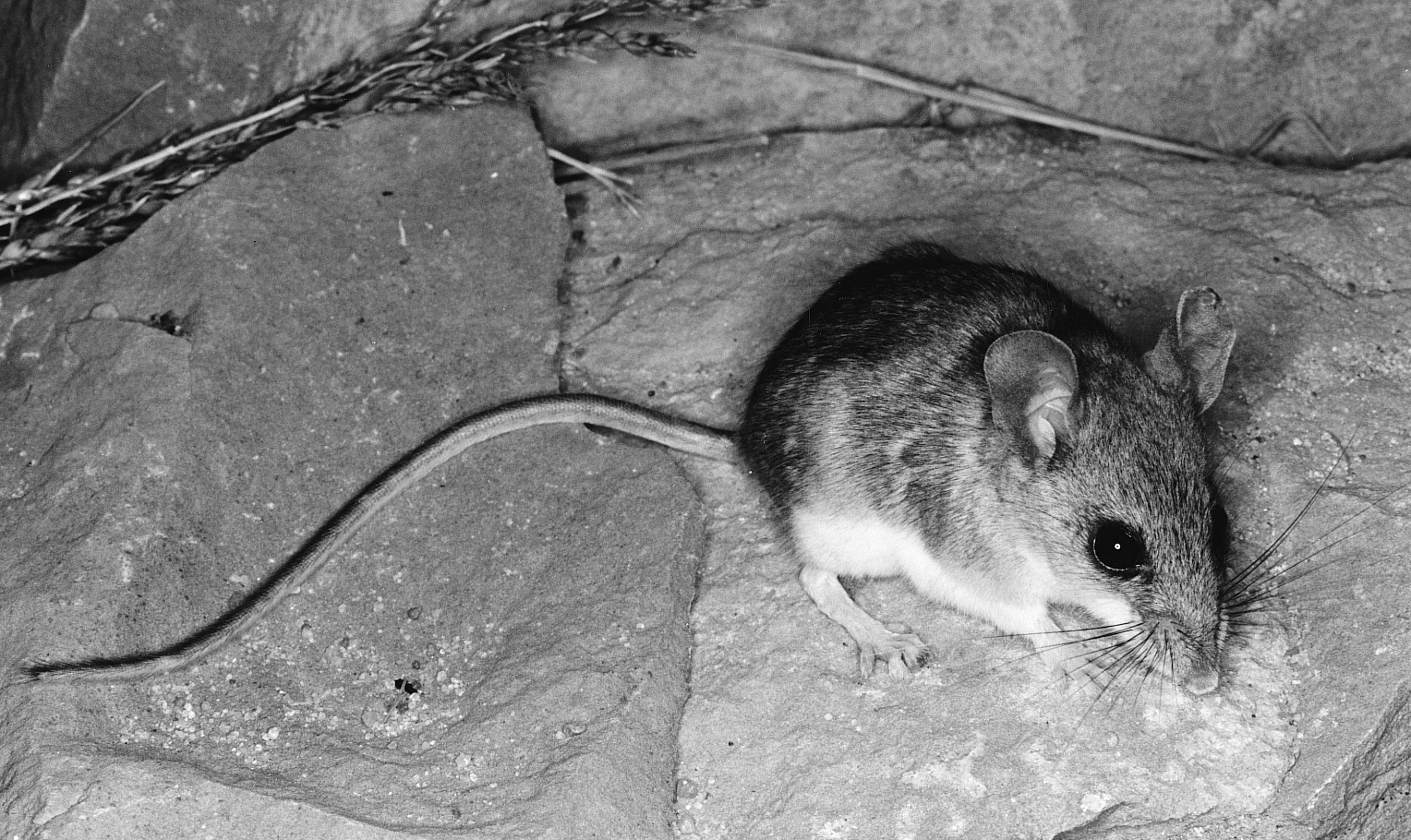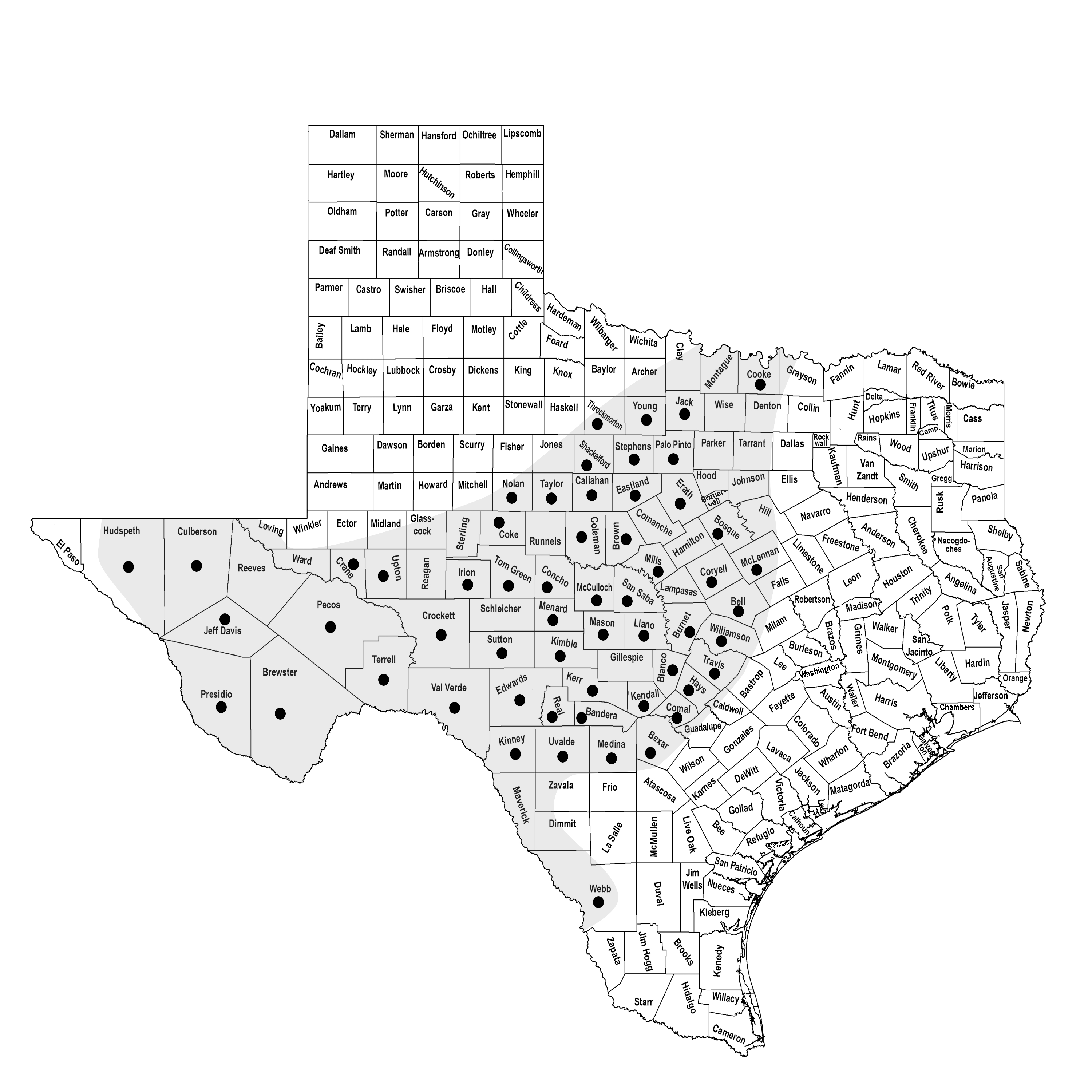LACEY'S WHITE-ANKLED DEERMOUSE
Peromyscus laceianus V. Bailey 1906
Order Rodentia : Family Cricetidae
DESCRIPTION.Peromyscus laceianus (formerly P. pectoralis, see "Remarks") is a small-eared, long-tailed deermouse with tarsal joint of hind foot white; pelage moderately long and lax; tail longer than head and body, scantily haired, not sharply bicolor but darker above than below, and annulations 20–24 per cm; upperparts grayish to wood brown; underparts and feet white; young bluish gray. Dental formula: I 1/1, C 0/0, Pm 0/0, M 3/3 × 2 = 16. Averages for external measurements: total length, 187 mm; tail, 95 mm; hind foot, 22 mm; ear, 16 mm. Weight, 24–39 g.
Most easily confused with P. eremicus, P. attwateri, and P. boylii. Distinguished from P. eremicus by having proximal part of sole of hind foot hairy rather than naked, mammae in three pairs rather than in two. Differs from P. boylii and P. attwateri in smaller scales on the tail, white rather than dusky tarsal joints, and shorter maxillary tooth row (often <4 mm).

DISTRIBUTION. Recorded from most of Trans-Pecos region and northeastward through the Edwards Plateau in the central part of state to Oklahoma (eastern limits of range along Balcones Escarpment from Bexar County northward to McLennan County).

SUBSPECIES. As it currently stands, this species is monotypic.
HABITS. Lacey's white-ankled deermouse is another rock-dwelling species, and it often is taken in the same habitat occupied by P. boylii and P. attwateri. The presence of rock, rather than vegetation type, seems to be the primary requirement for suitable habitat. In the Chisos Mountains and in the Delaware Mountains in Trans-Pecos Texas, they have been caught in the oak–juniper belt in traps set among jumbled boulders, near rock walls, in talus slopes, along rocky outcroppings, and in buildings. Near Austin, Lacey's white-ankled deermice are common in the rocky outcropping where the Colorado River cuts through the Balcones Escarpment; in Kerr County they prefer rocky bluffs along the rivers and creeks. In the Davis Mountains region of the Trans-Pecos, they usually are found in the grama–bluestem association. Elsewhere, they are associated with rocks in oak–juniper woodlands, but at Big Bend Ranch State Park they have been trapped in riparian woodlands.
They feed on a variety of seeds, including juniper berries, acorns, and hackberries. Although their diet has not been studied in detail, other seeds, cactus fruits, lichen, other fungi, and insects probably are consumed. These deermice are active nocturnally and do not hibernate through the winter months.
Their breeding habits are not well known, but it appears that several litters may be reared each year. Pregnant females have been captured from January through March and from July through December on the Edwards Plateau.
The average litter size is three, ranging from two to five. The gestation period has not been determined, but it is probably about 23 days as in closely related species. Growth and development of the young is not well known.
These mice are abundant in certain localities and may invade cabins and ranch buildings.
POPULATION STATUS. Common. Peromyscus laceianus is one of the most common deermice in central and West Texas and does not appear to face any serious threats. It appears to flourish under conditions of overgrazing and may be increasing in numbers throughout its range.
CONSERVATION STATUS. The IUCN lists the Lacey's white-ankled deermouse as a subspecies of P. pectoralis and considers P. pectoralis as a species of least concern. It does not appear on the federal or state lists of concerned species.
REMARKS.Peromyscus laceianus formerly was recognized as a subspecies of P. pectoralis with a distribution extending into central Mexico. In 2015, using DNA sequence and morphologic data, RDB, DJS, and colleagues elevated P. p. laceianus to species status and restricted the distribution to populations north of the Rio Grande. Populations in Mexico continue to be recognized as P. pectoralis.
From The Mammals of Texas, Seventh Edition by David J. Schmidly and Robert D. Bradley, copyright © 1994, 2004, 2016. Courtesy of the University of Texas Press.
Natural Science Research Laboratory
-
Address
Museum of Texas Tech University, 3301 4th street, Lubbock, TX 79409 -
Phone
806.742.2486 -
Email
nsrl.museum@ttu.edu

